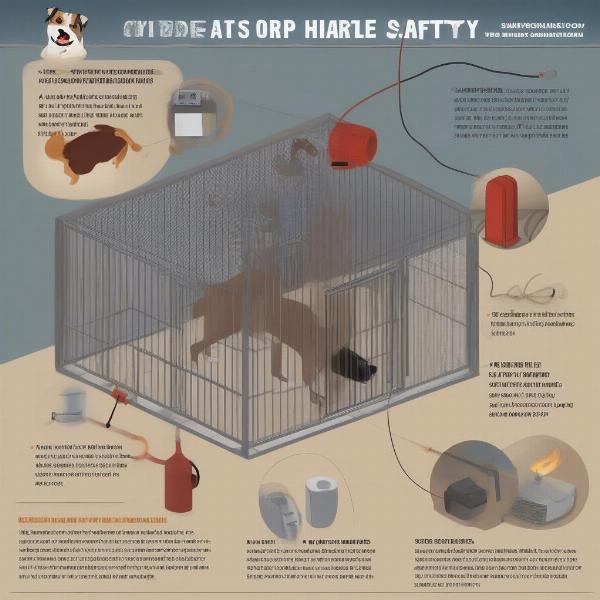Outdoor dog kennel heaters are a crucial investment for pet owners who house their dogs outside, especially during colder months. Ensuring your furry friend stays warm and comfortable is paramount, and a properly heated kennel can make all the difference between a shivering pup and a happy, healthy one. This article will delve into the various types of outdoor dog kennel heaters, factors to consider when choosing one, and tips for safe and effective usage.
Choosing the Right Outdoor Dog Kennel Heater
Selecting the appropriate heater depends on several factors, including your dog’s breed, size, age, the kennel’s size and insulation, and the climate you live in. For smaller kennels and milder climates, a heated dog mat or a low-wattage ceramic heater might suffice. Larger kennels in colder regions may require more powerful options like flat panel radiant heaters or forced-air heaters. Consider your dog’s specific needs and environment when making your choice.
Types of Heaters
- Radiant Heaters: These heaters warm objects directly, like your dog and the kennel floor, rather than the air. They are energy-efficient and provide consistent warmth.
- Ceramic Heat Emitters: These heaters use ceramic elements to radiate heat and are generally safe for use around pets.
- Heated Dog Mats: These mats provide a warm surface for your dog to lie on and are ideal for smaller breeds or as a supplemental heat source.
- Forced-Air Heaters: These provide quick and powerful heating but can dry out the air and should be used with caution.
 Dog Kennel Heater Safety Tips
Dog Kennel Heater Safety Tips
Safety First: Using Kennel Heaters Responsibly
Safety is paramount when using any heating device, especially around pets. Always ensure the heater is properly installed and out of your dog’s reach. Check for chewed cords and frayed connections regularly. Never use space heaters designed for human use in a dog kennel, as they can pose a fire hazard. Proper ventilation is essential to prevent carbon monoxide buildup and maintain air quality.
Ventilation is Key
Ensure adequate ventilation in the kennel to prevent moisture buildup and ensure fresh air circulation. This is particularly important when using heaters that can dry out the air.
Maintaining Optimal Kennel Temperature
The ideal temperature for a dog kennel varies depending on the breed, age, and overall health of your dog. Consult with your veterinarian for specific recommendations. Generally, a temperature between 45°F and 80°F is considered comfortable for most dogs. temperature controlled dog house Monitor the temperature regularly, especially during extreme weather conditions. You can also consider adding extra bedding or insulation to help retain heat. outdoor heating pad for dog house
Considering Your Dog’s Specific Needs
Different breeds have different tolerances to cold weather. Short-haired breeds and puppies are more susceptible to the cold and may require higher kennel temperatures. Senior dogs and those with health conditions may also benefit from supplemental heating. dog heater pad Consider your dog’s individual needs and adjust the heating accordingly. heating for dog kennels
Conclusion
Providing a warm and comfortable environment for your outdoor dog is essential, especially during colder months. Outdoor dog kennel heaters can significantly improve your dog’s well-being and protect them from the harsh elements. By carefully selecting the right heater, prioritizing safety, and considering your dog’s specific needs, you can ensure your furry companion stays cozy and content throughout the winter. igloo dog kennel sizes
FAQ
-
What type of heater is safest for a dog kennel? Radiant heaters and ceramic heat emitters are generally considered safe for dog kennels, as they don’t pose a significant fire hazard when used correctly.
-
How do I prevent my dog from chewing on the heater cord? Use cord protectors or run the cord through a conduit to make it inaccessible to your dog.
-
Can I use a space heater designed for humans in my dog’s kennel? No, never use space heaters designed for humans in a dog kennel. They can overheat and pose a serious fire risk.
-
What temperature should I maintain in my dog’s kennel during winter? Consult your veterinarian for breed-specific recommendations. Generally, a temperature between 45°F and 80°F is suitable for most dogs.
-
How can I improve the insulation of my dog’s kennel? Adding extra bedding, such as straw or blankets, and sealing any drafts can help improve insulation.
-
What are the signs of hypothermia in dogs? Signs of hypothermia include shivering, lethargy, weakness, and difficulty breathing.
-
How often should I check my dog’s kennel heater? Inspect the heater, cord, and connections regularly, especially before and during periods of cold weather.
ILM Dog is a leading international online resource dedicated to providing expert advice on dog care, breeds, health, training, nutrition, and more. We’re committed to helping dog owners worldwide provide the best possible care for their canine companions. From choosing the right breed to understanding their specific dietary needs, ILM Dog offers a wealth of information and resources. Contact us today for any inquiries or further assistance at [email protected] or +44 20-3965-8624. Visit us at ILM Dog for more expert advice and guidance.